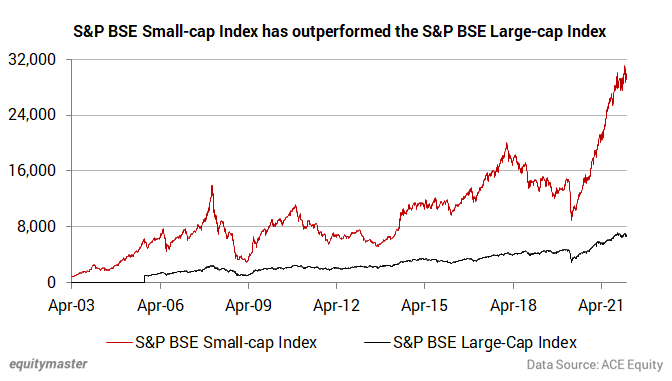- Home
- Views On News
- Feb 16, 2022 - Is it a Good Time to Buy Small-cap Stocks?
Is it a Good Time to Buy Small-cap Stocks?

Small-cap stocks are companies that have a market capitalisation of less than Rs 50 bn.
They are usually niche businesses that carry great potential. Since their marketcap is low, they carry more risks but can also offer higher returns.
Every investor can add some small-cap stocks to their portfolio. However, like any other type of investment, there are pros and cons to investing in small-cap stocks.
Here are some of the pros.
Strong growth
Small-cap stocks, by definition, have more growth opportunities than their larger counterparts. The logic behind this is simple.
It is easier and faster for a small business to double in size than a larger one. So, while a Sheela Foam can easily double its sales and profits within a span of two years, a Hindustan Unilever will find it tough to do the same.

This can be observed in the performance of the smallcap index as well.
It comes as no surprise that the S&P BSE small-cap index has outperformed the S&P BSE over the past 10 years.
Even when you study the individual stocks, 36% of the stocks in the mid-cap index today were a part of the small-cap index 10 years ago. This shows the scope of growth in a small-cap is tremendous.
Access to niche businesses
Small-cap stocks are a gateway to investing in niche growth stories.
Take Oriental Carbon & Chemicals for instance. It's the only company in India to manufacture a specialty chemical, insoluble sulphur (used to vulcanise rubber for manufacturing tyres) and is a market leader in the segment with a 60% share.
Even Sheela Foam, India's leading mattress company that owns the Sleepwell mattress brand is a great example. It's a market leader, with close to 30% share of the organised mattress market. This stock has been an investing favourite, growing phenomenally over the past few years.
But is now a good time to invest in small-cap stocks?
A good way to judge this is to look at the ratio of the small-cap index to the Sensex.
The long term median of this ratio is 0.43 with the previous peak at 0.58.
At present, the ratio is 0.5, indicating there is some scope for additional gains.
However, since it is higher than the long-term median of 0.43, small-cap stocks are not available at a deep discount to the past.
Small-cap stocks seem like a sure-fire route to greater returns. So, who wouldn't want that. But why don't people invest in only small-cap stocks?
Here are some of the cons.
Volatility
Volatility is the rate at which the price of a stock increases or decreases over a period. This volatility rises as you go down the marketcap ladder.
This is where your smallcaps are. Sure, they offer better returns than largecaps, but they also come with higher volatility.
As they are priced lower than largecaps or midcaps, they swing a lot more than their safer counterparts as markets move.
You'll notice that smallcaps outperform in bull markets but fall faster during bear markets.
This is because smaller companies don't have the financial strength to withstand slowdowns.
This risk of losses along with more volatile returns keeps investors away from small-cap stocks.
Suitable mainly for long-term investors
Small-caps are long-term plays, requiring you to be patient.
This means that you must only invest if you have surplus funds. Funds that you won't need for the next 7-10 years at the least.
For investors close to retirement they might not be a suitable investment.
Illiquid
Another risk factor when it comes to smallcaps is the low level of liquidity. Lying at the lower end of the marketcap spectrum, small-cap stocks are less liquid than their large counterparts.
This low level of liquidity can make these stocks potentially unavailable. It may also be difficult for investors to sell the stocks at a favourable price.
What should investors do?
Build a sound smallcap investing strategy.
A simple way to circumvent most of the risks is to build a sound investment strategy.
This involves building a portfolio that reflects your financial goals, helping you endure any major swings in the market.
Let us understand this better with an example.
Let's say you plan to invest in your child's education, 15 years from now.
Since your time horizon is longer, you can absorb more risk, i.e. withstand market swings. Thus, you can invest in 'riskier assets' such as smallcaps and aim for higher returns.
Imagine being invested in the past year. Every time the markets fell, smallcaps and midcaps crashed along with largecaps. But, if your investing horizon was longer, the fall wouldn't have bothered you. You could stay calm as you didn't require that money anytime soon.
Allocate capital wisely
If your portfolio reflects your financial goals always, you can endure any swing in the market. You can accept volatility, knowing there are other asset classes that will deliver returns when stocks are adversely affected in a downturn.
Note that in a scenario of ideal allocation of funds, small-cap stocks should not comprise more than 10% of one's total equity portfolio.
Further, a single small-cap stock should ideally not form more than 2-3% of the total portfolio. This allocation will vary from person to person.
Conduct thorough research
Another way to lower your level is risk is by doing research. Avoid companies whose businesses you don't understand. Study the current business and its prospects.
After all, the price you pay today is a function of the company's future earnings and assets.
You can start by using these filters can narrow down your search to quality companies for the next stage of analysis.
- A healthy balance sheet - Low leverage, i.e. a low debt-equity ratio and a high-interest coverage ratio is preferable.
- Strong cash flows - Check to see how long the cash flow from operations has been positive. The longer the history, the better it is.
- Consistent growth in earnings - Consistent growth in earnings is always a good sign. Not only does it imply the company is well-established, but it is also a sign of capable management.
- High Return of Equity - Companies in the non-financial sector must clock ROE of 15% or more. Financial companies must generate an ROE higher than 15%.
- Competent management - Prefer companies with a management that has a clean intent towards the shareholder.
- Bright business prospects - Market leaders in their fields can be great investments. The company should boast a great product or service.
- Attractive Valuations - Buy stocks with a margin of safety. If your expectations don't pan out, you have a cushion to absorb the shock.
Conclusion
Every investment carries a potential of return and risk. The key to investing successfully in any type of company, small or big, is to minimise your risks.
Focus on building a sound investment strategy. If you don't have one, start working towards it. If you do, check to see if your investments are on track and continue to reflect your investment horizon, financial situation, and risk tolerance.
If you work towards building a well-diversified portfolio of fundamentally strong companies with great potential, you will succeed.
Equitymaster requests your view! Post a comment on "Is it a Good Time to Buy Small-cap Stocks?". Click here!
1 Responses to "Is it a Good Time to Buy Small-cap Stocks?"


Slj
Feb 16, 2022Yes